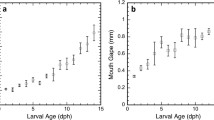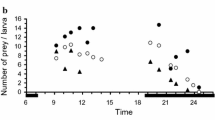Abstract
Results from field surveys with net sampling and video profiling, combined with laboratory experiments on feeding and growth, revealed the ecological function of Bolinopsis infundibulum in northern temperate coastal waters. B. infundibulum reaching a peak abundance of around 250 ctenophores m−2, in mid-May, followed by a dramatic reduction over the next few weeks, presumably explained by predation from the ctenophore Beroe cucumis. The field data on maximum individual body height in the population indicated an instantaneous growth rate of 0.129 d−1. Newly hatched cydippid larvae showed an average instantaneous growth rate of 0.240 d−1 over 4 weeks, whereas ctenophores in the size range of 4.4–9.8 mm height gave instantaneous growth rates between 0.10 and 0.20 d−1. B. infundibulum disappeared from surface water in mid-June, but big individuals were found in deeper water, where they preyed on copepods. The results indicate that the new generation of the year was recruited from February onwards. Laboratory predation and digestion experiments showed a continuous increase in predation rate with increased prey abundance, throughout the tested range of 5–400 copepods l−1, and a digestion time increasing from 39 min with a single copepod ingested to 73 min with 8 copepods ingested.








Similar content being viewed by others
References
Bailey, T. G., M. J. Youngbluth & G. P. Owen, 1994. Chemical composition and oxygen consumption rates of the ctenophore Bolinopsis infundibulum from the Gulf of Maine. Journal of Plankton Research 16: 673–689.
Baker, L. D. & M. R. Reeve, 1974. Laboratory culture of the lobate ctenophore Mnemiopsis mccradyi with notes on feeding and fecundity. Marine Biology 26: 57–62.
Båmstedt, U. & M. Youngbluth, 2000. Norwegian marine science goes deeper. Ocean Challenge 9: 25–30.
Båmstedt, U., H. Ishii & M. B. Martinussen, 1997. Is the scyphomedusa Cyanea capillata (L.) dependent on gelatinous prey for its early development? Sarsia 82: 269–273.
Berstad, V., U. Båmstedt & M. B. Martinussen, 1995. Distribution and swimming of the jellyfishes Aurelia aurita and Cyanea capillata. In Skjoldal, H. R., C. Hopkins, K. E. Erikstad & H. P. Leinaas (eds), Ecology of Fjords and Coastal Waters. Elsevier Science, London: 257–271.
Boersma, M., A. M. Malzahn, W. Greve & J. Javipour, 2007. The first occurrence of the ctenophore Mnemiopsis leidyi in the North Sea. Helgoländer Marine Research 61: 153–155.
Brodeur, R. D., C. E. Mills, J. E. Overland, G. E. Walters & J. D. Schumacher, 1999. Evidence for a substantial increase in gelatinous zooplankton in the Bering Sea, with possible links to climate change. Fisheries Oceanography 8: 296–306.
Costello, J. H., B. K. Sullivan, D. J. Gifford, D. Van Keuren & L. J. Sullivan, 2006. Seasonal refugia, shoreward thermal amplification, and metapopulation dynamics of the ctenophore Mnemiopsis leidyi in Narragansett Bay, Rhode Island. Limnology and Oceanography 51: 1819–1831.
Davis, C. S., S. M. Gallager & A. R. Solow, 1992. Microaggregations of oceanic plankton observed by towed video microscopy. Science 257: 230–232.
Falkenhaug, T., 1996. Distributional and seasonal patterns of ctenophores in Malangen, northern Norway. Marine Ecology Progress Series 140: 59–70.
Feigenbaum, D. & M. Kelly, 1984. Changes in the lower Chesapeake Bay food chain in presence of the sea nettle Chrysaora quinquecirrha (Scyphomedusa). Marine Ecology Progress Series 19: 39–47.
Gamble, J. C., 1974. Preliminary observations on the feeding of Bolinopsis infundibulum. International Council for the Exploration of the Sea, Committee Meeting 1974/L:14, Plankton Committee.
Gamble, J.C., 1977. Population structure, feeding behavior and fecundity of the lobate ctenophore, Bolinopsis infundibulum. International Council for the Exploration of the Sea, Committee Meeting 1977/L:16, Plankton Committee.
Greve, W., 1981. Invertebrate predator control in a coastal ecosystem: the significance of Beroe gracilis (Ctenophora). Kieler Meeresforschung Sonderheft 5: 211–217.
Haddock, S. D. H., 2007. Comparative feeding behavior of planktonic ctenophores. Integrative and Comparative Biology 47: 847–853.
Hamer, H. H., A. M. Malzahn & M. Boersma, 2011. The invasive ctenophore Mnemiopsis leidyi: a threat to fish recruitment in the North Sea? Journal of Plankton Research 33: 137–144.
Harbison, G. R., L. P. Madin & N. R. Swanberg, 1978. On the natural history and distribution of oceanic ctenophores. Deep Sea Research 25: 233–256.
Hansson, H. G., 2006. Ctenophores of the Baltic and adjacent seas – the invader Mnemiopsis leidyi is here! Aquatic Invasions 1: 295–298.
Hansson, L. J., O. Moeslund, T. Kiorboe & H. U. Riisgård, 2005. Clearance rates of jellyfish and their potential predation impact on zooplankton and fish larvae in a neritic ecosystem (Limfjorden, Denmark). Marine Ecology Progress Series 304: 117–131.
Hirst, A.G. & J. Forster, 2013. When growth models are not universal: evidence from marine invertebrates. Proceedings of the Royal society B – Biological Sciences. 280 (1768). Article number 20131546.
Kamshilov, M. M., 1960. Biology of ctenophores of Murman. International Council for the Exploration of the Sea, Committee Meeting 157.
Kremer, P. & S. Nixon, 1976. Distribution and abundance of the ctenophore, Mnemiopsis leidyi in Narragansett Bay. Estuarine and Coastal Marine Science 4: 627–639.
Martinussen, M. B. & U. Båmstedt, 1999. Nutritional ecology of gelatinous planktonic predators. Digestion rate in relation to type and amount of prey. Journal of Experimental Marine Biology and Ecology 232: 61–84.
Martinussen, M. B. & U. Båmstedt, 2001. Digestion rate in relation to temperature of two gelatinous planktonic predators. Sarsia 86: 21–35.
Mills, C., 2001. Jellyfish blooms: are populations increasing globally in response to changing ocean conditions? Hydrobiologia 451: 55–68.
Nagabhushanam, A. K., 1959. Feeding of a ctenophore, Bolinopsis Infundibulum (O.F. Muller). Nature, London 184:829.
Pauly, D., W. M. Graham, S. Libralato, L. Morissette & M. L. D. Palomares, 2009. Jellyfish in ecosystems, online databases, and ecosystem models. Hydrobiologia 616: 67–85.
Prosser, C. L., 1961. Oxygen, respiration and metabolism. In Prosser, C. L. & F. A. Brown Jr (eds), Comparative Animal Physiology. W.B. Saunders Co, Philadelphia & London.
Purcell, J. E., 2009. Extension of methods for jellyfish and ctenophore trophic ecology to large-scale research. Hydrobiologia 616: 23–50.
Purcell, J. E. & J. H. Cowan Jr, 1995. Predation by the scyphomedusan Chrysaora quinquecirrha on Mnemiopsis leidyi ctenophores. Marine Ecology Progress Series 129: 63–70.
Purcell, J. E., R. R. Hopcroft, K. N. Kosobokova & T. E. Whitledge, 2010. Distribution, abundance, and predation effects of epipelagic ctenophores and jellyfish in the western Arctic Ocean. Deep-Sea Research II 57: 127–135.
Raskoff, K. A., J. E. Purcell & R. R. Hopcroft, 2005. Gelatinous zooplankton of the Arctic Ocean: in situ observations under the ice. Polar Biology 28: 207–217.
Raskoff, K. A., R. R. Hopcroft, K. N. Kosobokova, J. E. Purcell & M. Youngbluth, 2010. Jellies under ice: ROV observations from the Arctic 2005 hidden ocean expedition. Deep-Sea Research II 57: 111–126.
Reeve, M. R., 1980. Comparative experimental studies on the feeding of chaetognaths and ctenophores. Journal of Plankton Research 2: 381–393.
Reeve, M. R., M. A. Walter & T. Ikeda, 1978. Laboratory studies of ingestion and food utilization in lobate and tentaculate ctenophores. Limnology and Oceanography 23: 740–751.
Reeve, M. R., M. A. Syms & P. Kremer, 1989. Growth dynamics of a ctenophore (Mnemiopsis) in relation to variable food supply. I. Carbon biomass, feeding, egg production, growth and assimilation efficiency. Journal of Plankton Research 11: 535–552.
Siferd, T. D. & R. J. Conover, 1992. Natural-history of ctenophores in the resolute passage area of the Canadian High Arctic with special reference to Mertensia ovum. Marine Ecology Progress Series 86: 133–144.
Sørnes, T. A. & D. L. Aksnes, 2004. Predation efficiency in visual and tactile zooplanktivores. Limnology and Oceanography 49: 69–75.
Stanlaw, K. A., M. R. Reeve & M. A. Walter, 1981. Growth, food, and vulnerability to damage of the ctenophore Mnemiopsis mccradyi in its early life history stages. Limnology and Oceanography 26: 224–234.
Swanberg, N., 1974. The feeding behavior of Beroe ovata. Marine Biology 24: 69–76.
Toyokawa, M., T. Toda, T. Kikuchi, H. Miyake & J. Hashimoto, 2003. Direct observations of dense occurence of Bolinopsis infundibulum (Ctenophora) near the seafloor under the Oyashio and notes on their feeding behavior. Deep sea research I. Oceanographic Research Papers 50: 809–813.
Viitasalo, S., M. Lehtiniemi & T. Katajisto, 2008. The invasive ctenophore Mnemiopsis leidyi overwinters in high abundance in the subarctic Baltic Sea. Journal of Plankton Research 30: 1431–1436.
Youngbluth, M. & U. Båmstedt, 2001. Distribution, abundance, behavior and metabolism of Periphylla periphylla, a mesopelagic coronate medusa that thrives in some Norwegian fjords. Hydrobiologia 451: 321–333.
Acknowledgments
The project was supported by the Norwegian Research Council, Projects No. 108084/122 and 146994/S40. Part of the project was also integrated in the EU-funded project EUROGEL (contract no EVK3-CT- 32002-00074). We thank the University of Bergen for working facilities at the Marine Biological Station and onboard R/V Hakon Mosby, and Umeå Marine Sciences Centre for working facilities during preparation of the results.
Author information
Authors and Affiliations
Corresponding author
Additional information
Field and laboratory work was carried out at the University of Bergen.
Guest editors: Yehuda Benayahu, Oren Levy & Tamar Lotan / Coelenterate Biology: Advanced Studies on Cnidaria and Ctenophora
Rights and permissions
About this article
Cite this article
Båmstedt, U., Martinussen, M.B. Ecology and behavior of Bolinopsis infundibulum (Ctenophora; Lobata) in the Northeast Atlantic. Hydrobiologia 759, 3–14 (2015). https://doi.org/10.1007/s10750-015-2180-x
Received:
Revised:
Accepted:
Published:
Issue Date:
DOI: https://doi.org/10.1007/s10750-015-2180-x




